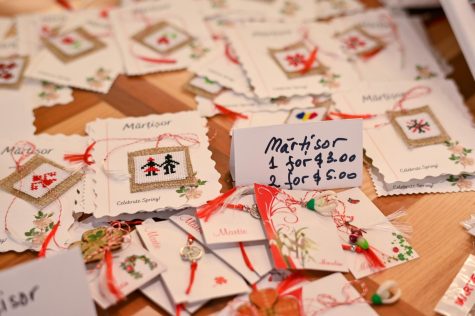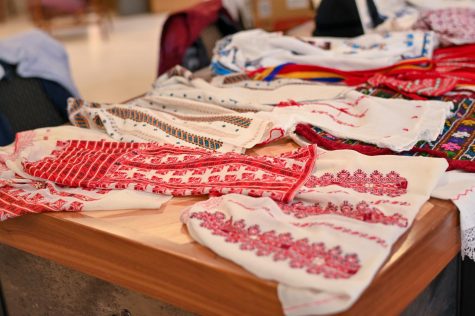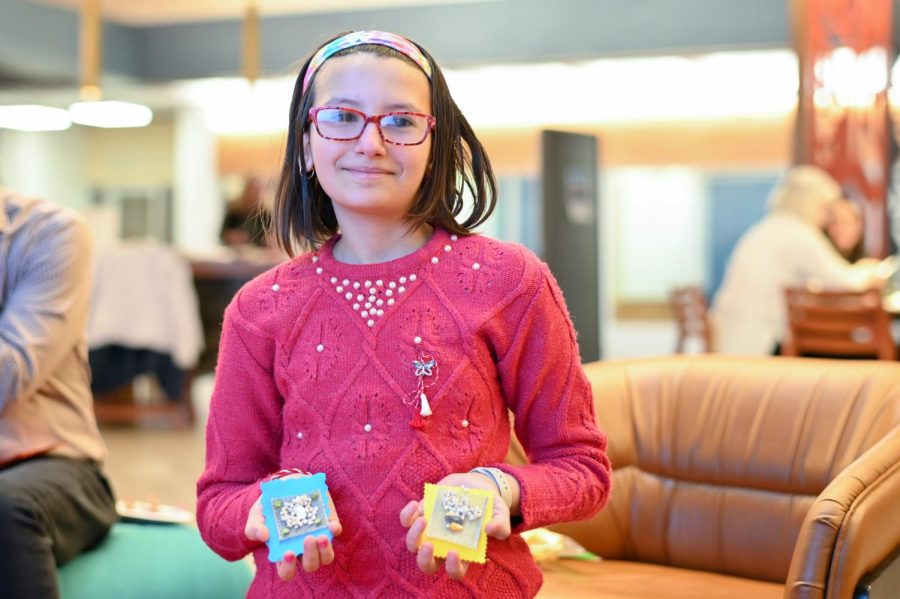Romanian Room Committee marches into spring with the luck of Mărțișor
Nate Yonamine | Senior Staff Photographer
A young girl wearing a Mărțișor at an event hosted by the Romanian Nationality Room Committee on Sunday in Posvar Hall.
February 27, 2023
A mother and daughter sat together Sunday afternoon in the Global Hub in Posvar Hall with smiles across their faces. In their hands were one red tassel and one white tassel coiled around each other to make a beautifully patterned cord with gems and flowers. This string is called a Mărțișor.
The Romanian Nationality Room Committee hosted an event to celebrate Mărțișor, a monthlong Romanian holiday that about 30 people attended. On March 1, Romanian people give Mărțișor to their loved ones as a part of the spring holiday celebration.
Ema Legersky, chair of the Romanian Nationality Room Committee and a Romanian native, said it’s inspiring to host the first in-person event since the COVID-19 pandemic. Legersky said Mărțișor’s purpose is to welcome spring and bring good luck.
“Over 2,000 years ago, people wore red and white stones to welcome spring,” Legersky said. “Nowadays, Mărțișor is mainly red and white strings with trinkets … You wear the Mărțișor on your chest starting with the first of March and at the end of the month you put your Mărțișor on the branch of the tree to pass the fertility and luck onto the land.”

According to Legersky, Mărțișor is a massive event in Romania celebrated by all, while in the U.S. it’s almost completely unknown. Legersky said when she first moved to the U.S., she was so focused on adjusting to a new culture that she forgot to remember her own.
“About a week before the 1st of March, we have huge Mărțișor street fairs, and you see hundreds and hundreds of different Mărțișors, you buy them and offer them to a lot of people like teachers and friends,” Legersky said. “As you settle in a new place and you form roots, you start missing those things that you had there [in Romania], so this was a great opportunity for me to get involved in keeping the traditions through the Romanian Nationality Room.”
Dana Lampert, a new member of the Romanian Nationality Room Committee and a Romanian native, said a Pitt event that honors Mărțișor brings back a lot of childhood memories. Lampert said it’s wonderful blending her Romanian traditions with her American life.
“When I was a kid, we were always waiting for March 1st to arrive to give Mărțișor to our best friends and the teachers we liked,” Lampert said. “I like that we can share this tradition with other cultures and nationalities.”
The Romanian Nationality Room Committee included other components of Romanian culture at the Mărțișor event. Committee members showcased and sold items such as baked goods, traditional Romanian blouses called ie, towels and opinci, which are traditional leather sandals.
“I cooked mushrooms and cheese-filled pastries which are very popular back home called Pateuri,” Lampert said.
Legersky also contributed to the baked goods on sale at the Mărțișor event.

“I did the cheese pastry, called Merdenele,” Legersky said. “It’s a traditional Romanian food, and it’s our version of street food.”
Andy Byron, the newest member of the Romanian Nationality Room Committee, shared that as an American in the Romanian committee, she’s able to expand her cultural views. Byron said her experience working with the committee has made her want to visit Romania again.
“Every once in a while I get a little intimidated,” Byron said. “But everyone has been beyond welcoming to me and allowing me to volunteer based on the skills I have to offer and constantly showing appreciation.”
Byron said more than 15 years ago, she visited Romania for the first time, and she’s still permanently impacted by her trip. The Mărțișor event is a great way to reconnect with her love for Romania, she said.
“In 2005, I took a trip with Habitat for Humanity International to work on housing in other countries,” Byron said. “That was in 2005, we’re in 2023. Romania got in my heart and it has not left … It’s been all this time and I still have an affection for it.
Legersky said she hopes to continue hosting more events revolving around Romanian culture.
“The Romanian community is very small and you end up knowing each other and becoming very close,” Legersky said.








